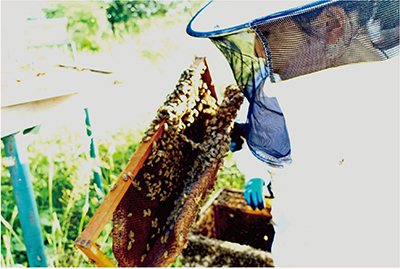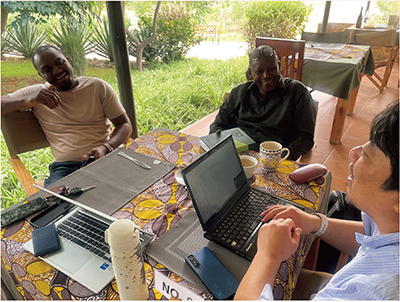MASTER TECHNIQUES from Japan to the World 1Public nomination
A Company from Gifu, the Birthplace of Japanese Modern Beekeeping, Contributing to Increasing Honey Yields in Tanzania

Checking that the bees have adapted themselves to the beekeeping equipment brought in from Japan (Photo: Nissin Honey Co., Ltd.)

A staff member of Nissin Honey Co., Ltd. (on the right) discussing with local beekeeping stakeholders (Photo: Nissin Honey Co., Ltd.)
Tanzania in East Africa is an agricultural country where approximately 70% of the population is engaged in agriculture. However, the growth rate of the agricultural sector remains low compared with other sectors, and the disparity between urban and rural areas as well as employment among the younger generation are challenges. The beekeeping industry produces approximately 30,000 tons of honey annually, making the country the second-largest producer in Africa, although the actual yield is reportedly much lower than its potential when considering the climate and abundance of nectar sources (plants from which bees collect nectar to make honey). One of the reasons for this is the use of traditional beekeeping technology by smallholder farmers.
Therefore, Nissin Honey Co., Ltd., which is based in Gifu Prefecture, known as the birthplace of Japanese modern beekeeping, and is engaged in manufacturing and importing honey products, utilizes JICA’s SDGs Business Supporting Survey to introduce modern beekeeping in Tanzania.
Japan depends on imports for most of its honey consumption. Nissin Honey, which imports honey mainly from South America, Eastern Europe, and Southeast Asia, began considering Tanzania as an option for diversifying the company’s import sources. Mr. KISHINO Hayato, CEO and President of Nissin Honey explains the reason for their choice: “We estimated that, by introducing Japanese modern beekeeping technology, we would be able to increase the honey yield in Tanzania, where honey is collected using traditional methods.”
“This project was a new attempt for our company, as it was about not only importing honey, but also developing local human resources and improving production capacity. The issues we addressed first were the introduction of Japanese-style beehive boxes and the aggressive nature of the local bees,” says Mr. Kishino, looking back on the early days of the project.
Traditional beekeeping in Tanzania uses beehive boxes that are nearly four times the size of those in Japan and waits for bees to arrive at a fixed location. With this method, it is difficult to move the hives to areas with flowers, and it takes several months to collect enough honey, which reduces its quality. To tackle this issue, Nissin Honey starts this project by introducing compact and mobile Japanese-style beehive boxes. In order to ensure a stable supply of beehive boxes, Nissin Honey plans to set up a system to manufacture and distribute beehive boxes using local wood, in cooperation with a company in Miyazaki Prefecture in Japan. Mr. Kishino says, “The introduction of compact beehive boxes enables the local people to move the hives to areas with flowers and collect honey efficiently. In addition, smaller beehive boxes are easier for women to handle, which encourages women’s participation,” as the explanation of the benefits of Japanese-style beehives.
Regarding another challenge of the aggressive nature of African honeybees, it poses a high risk of beekeepers being stung while working. Therefore, Nissin Honey, with the cooperation of JICA, works with local universities and research institutes to increase the number of bees suitable for beekeeping by placing honeybees in an environment where they do not need to be aggressive, repeating crossbreeding for three generations, and selecting less aggressive bees.
According to Nissin Honey, it has been confirmed that the yield can be increased to nearly four times that of traditional beekeeping by incorporating modern beekeeping technology. Local beekeepers, who were initially skeptical about the introduction of new technology, have come to have high expectations for the introduction of Japanese beekeeping technology. Regarding the company’s future prospects in Tanzania, Mr. Kishino says, “Our goal is to further increase production and stabilize the business by 2026, and we have to work not only on human resources development of beekeepers for increasing the production, but also on quality issues, including taste and color. We aim to resolve these issues and deliver honey from Tanzania to Japanese dining tables while increasing and stabilizing the income of Tanzanian beekeepers.”
Next Page >>
Main Text | Reference Statistics | Stories from the Field | Master Techniques from Japan to the World | ODA Topics
